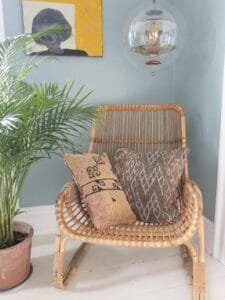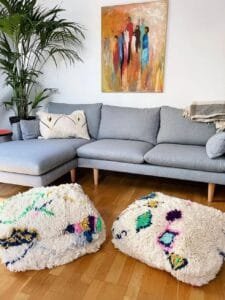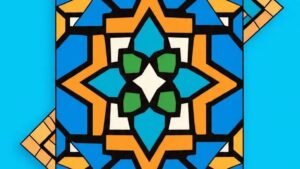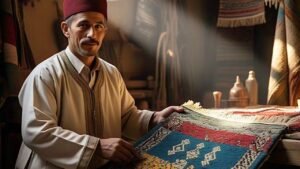
The Moroccan Berber cushion, with its vibrant hues and intricate patterns, is more than a home accessory—it is a storyteller, a keeper of memories, and a bridge between generations. Nestled in the heart of Morocco, where the Atlas Mountains meet the sky and the Sahara whispers ancient secrets, this tradition of artisanship has woven itself into the fabric of human history. Each stitch, each thread, carries the soul of the Berber people, their resilience, and their deep connection to the land. To choose a Moroccan Berber cushion is not merely to decorate a space; it is to invite a piece of this rich heritage into your home, allowing its colors and textures to speak of distant horizons and timeless beauty.
The legacy of Moroccan Berber Cushions

The Moroccan Berber cushion is not just an object; it is a testament to a culture that has thrived for centuries. The Berber people, indigenous to North Africa, have long used textiles as a means of expression, weaving symbols and stories into every piece. These cushions, often handcrafted by women in remote villages, are imbued with meanings that transcend their aesthetic appeal. The geometric patterns, for instance, are not random designs but representations of the natural world—mountains, rivers, and stars—as well as spiritual beliefs that have been passed down through generations.
When you hold a Moroccan Berber cushion, you are holding a piece of history. The wool, often sourced from local sheep, is dyed using natural pigments derived from plants, minerals, and even insects. This process, though time-consuming, ensures that each cushion is unique, its colors echoing the earthy tones of the Moroccan landscape. The craftsmanship is meticulous, with every knot and weave reflecting the artisan’s dedication to preserving their cultural heritage.
To choose a Moroccan Berber cushion is to honor this legacy. It is to recognize the hands that have toiled over it, the stories it carries, and the traditions it upholds. In a world increasingly dominated by mass production, these cushions stand as a reminder of the beauty and value of handmade artistry.
The palette of the Moroccan Berber Cushion

The colors of a Moroccan Berber cushion are not chosen at random; they are a language in themselves. Deep reds evoke the warmth of the desert sun, while blues mirror the endless skies and the Mediterranean Sea. Earthy browns and greens speak of the fertile valleys and rugged mountains, grounding the designs in the natural world. Each color tells a story, and together, they create a tapestry that is as rich in meaning as it is in beauty.
Consider the vibrant saffron yellow often found in these cushions. This hue, derived from the saffron crocus, is a symbol of prosperity and joy. It is a color that has been cherished in Moroccan culture for centuries, used not only in textiles but also in cuisine and rituals. Similarly, the deep indigo blue, achieved through traditional dyeing techniques, represents protection and spirituality. It is a color that has traveled across trade routes, from the depths of the Sahara to the bustling souks of Marrakech.
When selecting a Moroccan Berber cushion for your home, let the colors guide you. Think of the emotions they evoke and the stories they tell. A cushion with bold, contrasting hues might bring energy and vitality to a space, while one with softer, muted tones could create a sense of calm and serenity. The palette you choose will not only reflect your personal style but also connect you to the cultural essence of Morocco.
The Symbolism of Moroccan Berber Cushion

The patterns adorning Moroccan Berber cushions are more than decorative elements; they are a visual language that has been passed down through generations. Each symbol carries a specific meaning, often rooted in the Berber people’s connection to nature and their spiritual beliefs. The zigzag, for instance, represents water—a precious resource in the arid landscapes of Morocco. The diamond shape, on the other hand, symbolizes femininity and fertility, reflecting the central role of women in Berber society.
One of the most iconic motifs found in Berber textiles is the “eye” or “hand of Fatima,” a symbol of protection against evil. This design, often intricately woven into cushions, serves as a reminder of the spiritual beliefs that have guided the Berber people for centuries. Another common pattern is the “tree of life,” which signifies growth, resilience, and the interconnectedness of all living things. These symbols, though ancient, continue to resonate with modern audiences, offering a sense of continuity and connection.
When choosing a Moroccan Berber cushion, take the time to understand the patterns and their meanings. Let the designs speak to you, and consider how they might complement your space. A cushion adorned with protective symbols might find its place in a cozy reading nook, while one featuring nature-inspired motifs could bring a touch of the outdoors into your living room. Each pattern tells a story, and by incorporating these cushions into your home, you become a part of that narrative.
Integrating Berber Cushions into Your Home

A Moroccan Berber cushion is not just a decorative item; it is a statement piece that can transform a space. Its vibrant colors and intricate patterns make it a focal point, drawing the eye and inviting conversation. Whether placed on a sofa, a bed, or a floor seating area, these cushions have the power to infuse a room with warmth and character.
In a minimalist setting, a single Moroccan Berber cushion can serve as a bold accent, adding a splash of color and texture to an otherwise neutral palette. In a more eclectic space, multiple cushions can be layered to create a cozy, inviting atmosphere. The key is to balance the boldness of the cushions with the overall aesthetic of the room, allowing them to shine without overwhelming the space.
Consider the function of the room when choosing your cushions. In a living room, they might be arranged on a sofa or armchair, providing both comfort and visual interest. In a bedroom, they could be placed on a bed or in a reading corner, creating a sense of tranquility and warmth. Wherever you choose to place them, these cushions will bring a touch of Moroccan artistry into your home, enriching your space with their beauty and history.
The Enduring Appeal of the Moroccan Berber Cushion

In a world where trends come and go, the Moroccan Berber cushion remains a timeless piece, its appeal undiminished by the passage of time. This is not merely because of its aesthetic beauty but because of the stories it carries and the traditions it represents. Each cushion is a labor of love, a testament to the skill and dedication of the artisans who create it.
Investing in a Moroccan Berber cushion is not just a purchase; it is a commitment to preserving a cultural heritage. These cushions are made to last, their durable materials and meticulous craftsmanship ensuring that they can be enjoyed for generations. They are pieces that grow more beautiful with time, their colors softening and their patterns becoming even more meaningful as they become a part of your own story.
When you bring a Moroccan Berber cushion into your home, you are not just adding a decorative item; you are embracing a piece of history, a connection to a culture that has thrived for centuries. It is a choice that speaks of appreciation for artistry, a love of beauty, and a desire to create a home that is not only stylish but also deeply meaningful. In a world that often feels fleeting, these cushions offer a sense of permanence, a reminder of the enduring power of human creativity and connection.




